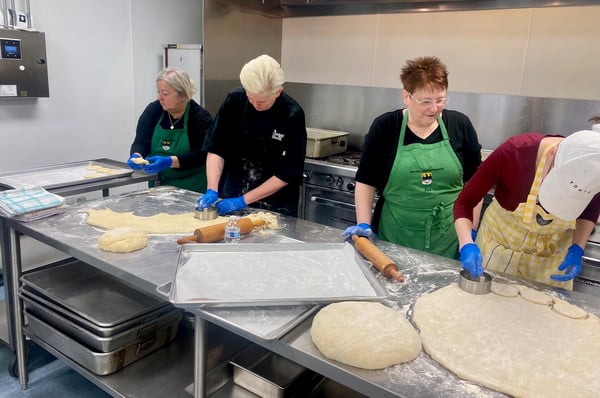Every once in a while, I get a call for help from my dear friend Carol Himmel and when she calls, I jump. Carol is always helping others, donating her time, energy, resources and attention so when she needs me, I am always honored to oblige.
Carol is chef and co-owner of Himmel’s restaurant in Lincoln Square, owner of Erich’s Lehigh Auto Body Shop, director of the German American Children’s Choir, band member of the Tuesdays, vice-president of the German American Association, and these are just some of the things she is up to. On a recent Sunday, I had an opportunity to join her and the wonderful volunteers at The Society of the Danube Swabians as they prepared authentic Krapfen for their annual Carnival (Fasching) fundraiser. Fasching Krapfen is the traditional carnival donut served at these special occasions.


Krapfen
Although these donuts are traditionally served at German Carnival celebrations, they are perfect anytime you want to enjoy a freshly cooked donut at home.
Scroll down for a printable version of this recipe
Recipe compliments of: Carol Himmel
Yield: 2 dozen donuts
Prep time: 1 hour
Inactive time: 2-4 hours
Cook time: 5 minutes
Start to finish: 3 to 5 hours
1/2 cup warm milk (110-115 degrees)
1 Tablespoon sugar
1 package dry yeast or 2 1/4 teaspoons
2 cups cold milk
2 Tablespoons brandy (secret ingredient)
3 Tablespoons vegetable or grapeseed oil
2 whole eggs
1/4 teaspoon salt
5 cups all-purpose flour
Extra flour for dusting, kneading and rolling surface
Approximately 1/2 gallon vegetable oil for frying
Step 1: Prove Yeast
Warm the 1/2 cup of milk on the stove over low heat. You want to keep the milk between 110-115 degrees. If you overheat the milk, it can kill the yeast and if the milk is too cold it will take much longer to activate.
While the yeast is proving, start measuring all your liquid ingredients into a large mixing bowl: 2 cups cold milk, 2 tablespoons of brandy and 3 tablespoons of vegetable oil.
This dough is relatively sticky to start with. Sprinkle a light and even layer of flour over your dough and mix it in the bowl. Knead together adding flour as needed until the dough is only slightly sticky and starts to smooth out a bit. This should just take just a few minutes, no more than five. Do not over knead this dough, we want a nice tender Krapfen.
Cover the bowl with clean dry towel or plastic wrap. Let it rise in a warm spot, not a hot spot. Room temperature is good, somewhere between 70 and 80 degrees.
*Alternatively, you can take the dough and put it in the refrigerator at this point. Make sure to cover it with plastic wrap, which will keep the dough moister than a towel. You can let the dough rise overnight in the refrigerator and pull it out in the morning. You need to let the dough reach room temperature, which will take several hours. Once it reaches room temperature continue to step 5. When you want to cook the Krapfen in the morning, this technique can be a whole lot faster.
*Remember if you let the dough rise overnight in the refrigerator, just skip this part. The rising happened in the refrigerator. All you do now is to let the dough reach room temperature so you can shape it.
Lightly flour your work surface with an even layer of flour and pour the dough out on to the surface. Divide the dough in half with a dough scraper or knife.
*Note that Carol is doing enough dough for 200 Krapfen in this video, many times the size of the recipe provided here.
Starting with half of the dough, lightly sprinkle it with flour and form into a smooth even ball. Do the same with the other half of the dough.
Cover the dough balls with a clean dry towel and let them rest for 10 to 15 minutes to relax the gluten and make them easier to roll.
Put an even and light layer of flour onto your work surface and place one dough ball onto the surface. With a rolling pin roll the dough into a 1/4-inch thick circle.
With a 3-inch round cutter, cut the rolled-out dough into circles. Place the circles on a lightly floured sheet pan and cover with a clean dry dish towel.
Step 6: Time to Cook the Donuts
A heavy gauge pan that is deeper than it is wide is ideal for frying, something like an 8-quart stock pot or French oven. You want to have ample room between the level of the oil and the top of the pan. When you add the donuts to the hot oil, the oil level will rise but it will also bubble up when the oil is sufficiently hot. You really do not want your hot oil to be bubbling over the edge of the pan and on to your stove top. This is a real safety issue.
At the same time, you need enough oil in the pan to cover the Krapfen, the oil should be about 6 inches deep.
It helps when using powdered sugar to let the donut cool just slightly. I like to cool it ever so slightly by placing the Krapfen on a paper towel or a cooling rack placed over a jelly roll pan after I pull it out of the hot oil. Immediately after I do this, then I sprinkle them with powdered sugar.
If you are interested in more authentic regional dishes and fundamental cooking techniques, we have so much to offer both virtually and in person. Check out our class calendar to see what strikes a craving! And if donuts interest you (who isn't interested by donuts?!), you can't miss our Donut Boot Camp this summer on Saturday, June 3 at 10am at Lincoln Square.
Krapfen
Ingredients
- 1/2 cup warm milk (110-115 degrees)
- 1 Tablespoon sugar
- 1 package dry yeast or 2 1/4 teaspoons
- 2 cups cold milk
- 2 Tablespoons brandy (secret ingredient)
- 3 Tablespoons vegetable or grapeseed oil
- 2 whole eggs
- 1/4 teaspoon salt
- 5 cups all-purpose flour
- Extra flour for dusting, kneading and rolling surface
- Approximately 1/2 gallon vegetable oil for frying
Instructions
- Warm the 1/2 cup of milk on the stove over low heat to 110-115 degrees.
- Add 1 tablespoon of sugar to the warm milk and sprinkle the package of yeast over that. Let the yeast set for about 5 minutes until the surface starts to foam up.
- While the yeast is proving, start measuring all your liquid ingredients into a large mixing bowl.
- Once the yeast is bubbling, pour that mixture into the liquid ingredients.
- Add the 2 eggs, 1/4 teaspoon of salt and 5 cups of flour to the liquid ingredients and mix with a wooden spoon until the mixture comes together somewhat.
- Sprinkle a light and even layer of flour over your dough and mix it in the bowl. Knead together adding flour as needed until the dough is only slightly sticky and starts to smooth out a bit. This should just take just a few minutes, no more than five.
- Cover the bowl with a clean dry towel or plastic wrap and let it rise in a warm spot.
- Check the dough after 2 hours by pushing into the dough gently with your finger. If the dough bounces back, the dough needs to continue to rise. Let the dough rise until the indentation of your finger remains, somewhere between 2 and 4 hours.
- Lightly flour your work surface with an even layer of flour and pour the dough out on to the surface. Divide the dough in half with a dough scraper or knife.
- Starting with half of the dough, lightly sprinkle it with flour and form into a smooth even ball. Do the same with the other half of the dough.
- Cover the dough balls with a clean dry towel and let them rest for 10 to 15 minutes.
- Put an even and light layer of flour onto your work surface and place one dough ball onto the surface. With a rolling pin roll the dough into a 1/4-inch thick circle.
- With a 3-inch round cutter, cut the rolled-out dough into circles. Place the circles on a lightly floured sheet pan and cover with a clean dry dish towel.
- Leave the dough as is in the 3-inch circles or create a slight divot in the center for a dollop of jam. The divot is made by simply stretching the dough a little thinner in the center.
- Heat your pot of oil until it measures 365-375 degrees on a candy thermometer.
- Place the Krapfen in the oil dropping them in the oil gently and away from you. Once the first side is golden brown, turn it over to brown the other side, approximately 2 to 3 minutes per side. Remove the Krapfen out of the hot oil.
- If using granulated sugar to coat the donut, place the Krapfen directly into granulated sugar once you take it out of the hot oil and toss it in the sugar.
- If using powdered sugar to coat the donut, let the donut cool just slightly then sprinkle with powdered sugar.
